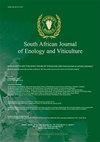Effect of Irrigation Using Diluted Winery Wastewater on the Chemical Status of a Sandy Alluvial Soil, With Particular Reference to Potassium and Sodium
IF 1.1
4区 农林科学
Q4 FOOD SCIENCE & TECHNOLOGY
引用次数: 5
Abstract
The re-use of winery wastewater for irrigation was investigated in a field trial with micro-sprinklerirrigated Cabernet Sauvignon/99 Richter in the Breede River Valley region of South Africa. Irrigation with winery wastewater diluted with river water to 100, 250, 500, 1 000, 1 500, 2 000, 2 500 and 3 000 mg/L chemical oxygen demand (COD) was compared to irrigation with river water. No trends were found in soil pH(KCl) and electrical conductivity of the saturated soil extract (ECe ) that were related to the different levels of dilution. However, ECe was considerably higher after the application of diluted winery wastewater irrigations compared to ECe at bud break. This suggests an accumulation of salts from the diluted winery wastewater. Under the prevailing conditions, soil K+ and Na+ increased with a decrease in the dilution of the winery wastewater. Increases in K+ could have a negative impact on wine colour stability should potassium be taken up by the grapevine in sufficient quantities, particularly if soil K+ accumulates to such an extent that it is luxuriously absorbed by grapevines. There were no consistent trends with regard to soil organic C, which indicates that there was too little organic material in the wastewater to have had a positive effect on soil fertility. Furthermore, organic material in the wastewater probably oxidised when the soil was aerated between irrigations. Although irrigation with diluted winery wastewater had almost no other effects, element accumulation, particularly with respect to K+ and Na+, might be more prominent in heavier soils or in regions with low winter rainfall.稀酒厂废水灌溉对沙质冲积土化学状态的影响,特别是对钾和钠的影响
在南非布里德河谷地区进行了赤霞珠/99 Richter微喷灌溉的田间试验,研究了酒庄废水的再利用。将酒庄废水经河水稀释至100、250、500、1 000、1 500、2 000、2 500、3 000 mg/L的化学需氧量(COD)与河水灌溉进行了比较。土壤pH(KCl)和饱和土壤浸出物电导率(ECe)的变化趋势与不同稀释程度无关。然而,与发芽时的ECe相比,施用稀释的酒厂废水灌溉后的ECe要高得多。这表明稀释后的酒厂废水中积累了盐。在一般条件下,土壤K+和Na+随酒废水稀释度的降低而升高。如果葡萄藤吸收钾的量足够,特别是土壤K+积累到葡萄藤大量吸收钾的程度,那么K+的增加可能会对葡萄酒颜色的稳定性产生负面影响。土壤有机碳变化趋势不一致,说明废水中有机质含量过低,对土壤肥力没有积极影响。此外,在两次灌溉之间给土壤充气时,废水中的有机物质可能被氧化。虽然用稀释的酒厂废水灌溉几乎没有其他影响,但元素积累,特别是K+和Na+,可能在较重的土壤或冬季降雨量少的地区更为突出。
本文章由计算机程序翻译,如有差异,请以英文原文为准。
求助全文
约1分钟内获得全文
求助全文
来源期刊
CiteScore
2.50
自引率
7.70%
发文量
1
审稿时长
>36 weeks
期刊介绍:
The South African Journal of Enology and Viticulture (SAJEV) publishes full-length original Research Papers, Research Notes and Review Papers on all subjects related to enology and viticulture. The SAJEV does not accept articles published in, or submitted to, other journals.

 求助内容:
求助内容: 应助结果提醒方式:
应助结果提醒方式:


